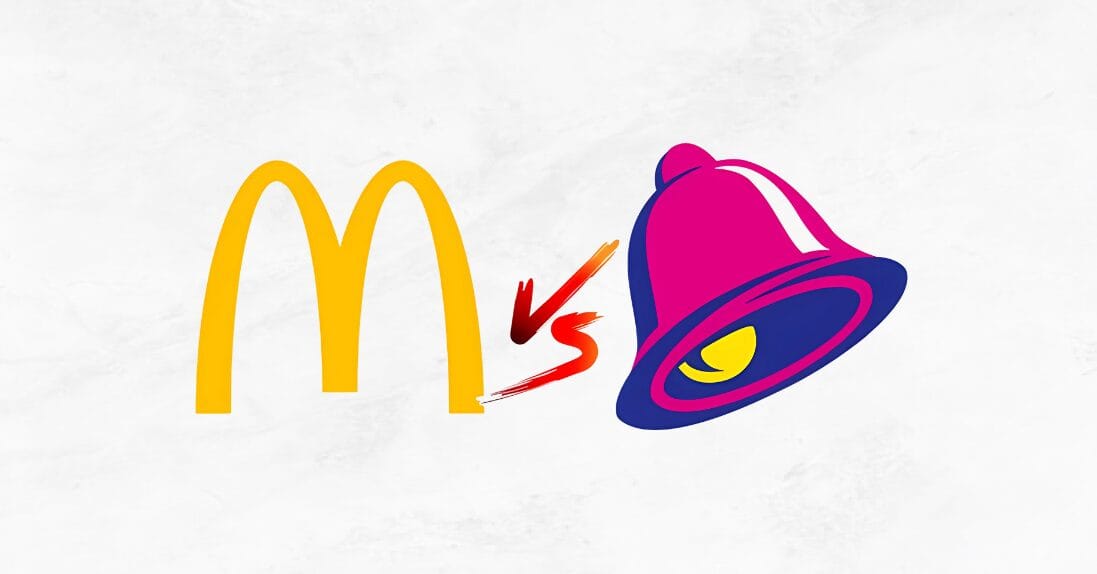When it comes to fast food, both McDonald’s and Taco Bell have dominated the industry. Not just through their food but also their innovative and powerful marketing strategies. As McDonald’s vs. Taco Bell, each brand approaches its advertising, target market, and promotions in unique ways. These ways have helped to shape their global presence and appeal to different consumer bases. Also in this marketing-focused comparison, we’ll explore the key elements of McDonald’s vs. Taco Bell marketing strategies including their brand positioning, audience targeting, promotional tactics, digital presence, and how they leverage their unique selling propositions (USPs) to win customer loyalty.
1. Brand Positioning of McDonald’s vs. Taco Bell: Global Icon vs. Bold Challenger
McDonald’s: The Global Icon McDonald’s brand positioning focuses on being a family-friendly, globally recognized brand that offers affordable, convenient meals with consistent quality. The company’s famous “I’m Lovin’ It” slogan reinforces a positive emotional connection with customers, emphasizing happiness, comfort, and familiarity. This positioning resonates with a wide audience, from kids to adults, across different cultures and regions. McDonald’s advertising often highlights its iconic products (like the Big Mac and McNuggets) and family-oriented experiences. Thus, through decades of consistent messaging, McDonald’s has established itself as the go-to fast-food destination for families, travelers, and budget-conscious consumers alike. Its golden arches are universally recognized, making McDonald’s synonymous with fast food.
Taco Bell: The Bold Challenger Taco Bell, in contrast, positions itself as a bold, youthful, and edgy brand with a rebellious attitude. Its marketing campaigns often feature quirky, humorous, and unconventional themes designed to appeal to a younger, adventurous audience. As Taco Bell embraces its role as the fast-food disruptor, constantly innovating its menu with unexpected, over-the-top items like the Doritos Locos Tacos and the Crunchwrap Supreme. Their slogan “Live Más” embodies this adventurous and energetic spirit, encouraging customers to enjoy life to the fullest through their food choices. Taco Bell also embraces the “late-night” crowd, appealing to college students, young adults, and those looking for affordable, flavorful meals after traditional restaurant hours.
2. Target Audience: Broad Appeal vs. Youth-Centric Focus
McDonald’s: Broad, Multigenerational Appeal McDonald’s targets a broad audience, spanning multiple generations and demographics. From families with young children to working professionals looking for a quick lunch, McDonald’s positions itself as an accessible brand for everyone. The introduction of healthier options and premium coffee products under the McCafé line also aims to attract health-conscious consumers and coffee lovers.
McDonald’s marketing heavily emphasizes family-friendly promotions, kids’ meals (Happy Meals), and partnerships with movies or toy brands, which help attract younger audiences. Meanwhile, value-driven campaigns like the Dollar Menu and meal deals appeal to price-sensitive consumers.
Taco Bell: Youthful and Edgy Taco Bell’s marketing efforts focus heavily on the Millennial and Gen Z demographics. Their advertising taps into the energy and lifestyle of younger consumers, often using social media trends, memes, and influencer partnerships. These trends create buzz and engage with a younger audience. Taco Bell’s late-night menu, unique flavor combinations, and quirky advertising resonate with young adults seeking affordable, bold, and unconventional food choices. By incorporating pop culture references and humor into their campaigns, Taco Bell has cultivated a loyal following among the younger, more socially connected crowd.
3. Promotional Tactics: Traditional Family Values vs. Digital Innovation
McDonald’s: Family Promotions and Iconic Collaborations McDonald’s has built its marketing success on traditional advertising channels. Such as TV, radio, and billboards, focusing on broad-based promotions that emphasize family values, community involvement, and nostalgia. McDonald’s frequently collaborates with global icons and celebrities to strengthen its brand appeal, including partnerships with athletes, artists, and even musicians (e.g., the Travis Scott and BTS meals).
Additionally, McDonald’s uses seasonal promotions, such as the McRib or Shamrock Shake, to drive excitement and customer traffic. The company also focuses heavily on localizing its menu and marketing to reflect regional tastes and preferences in different countries.
Taco Bell: Pop Culture, Limited-Time Offers, and Digital Innovation Taco Bell thrives on limited-time offers (LTOs), constantly rolling out new, bold menu items. That items create a sense of urgency and excitement. Their approach is highly centered around digital engagement, using social media trends, mobile apps, and influencer marketing to spread the word. This strategy keeps Taco Bell’s brand relevant and top-of-mind for young, trend-savvy consumers.
Taco Bell’s marketing campaigns often leverage pop culture and humor to resonate with its audience. From its famous 2000s “Yo Quiero Taco Bell” Chihuahua campaign to partnerships with esports and gaming platforms. Taco Bell knows how to capture attention through unconventional and meme-worthy content.
Taco Bell has also embraced mobile technology, encouraging customers to use their app for exclusive deals, rewards, and easy order customization. The app promotes loyalty through a personalized experience, further solidifying the brand’s connection to tech-savvy, digitally native consumers.
4. Digital Presence and Social Media of McDonald’s vs. Taco Bell: Consistency vs. Creativity
McDonald’s: Consistent, Global Digital Campaigns McDonald’s maintains a consistent and polished digital presence, reflecting its global brand identity. On social media, McDonald’s uses a mix of product-focused posts, promotional content, and community engagement. The brand keeps its content clean and professional, aligning with its family-friendly image. Their social media often highlights promotions, new menu items, and limited-time offers. While also engaging followers with lighthearted posts and questions. McDonald’s has also developed a strong mobile app to offer loyalty rewards, mobile ordering, and personalized offers. The app is integral to their strategy to drive sales and improve the customer experience through seamless convenience.
Taco Bell: Creative and Bold on Social Media Taco Bell excels at social media creativity, leveraging platforms like TikTok, Instagram, Pinterest and Twitter to engage with its younger audience. The brand’s social media presence is known for its witty making it highly relatable to Millennials and Gen Z. It often taps into trending memes, pop culture references, and humorous content to keep the conversation going with their audience. Their approach to digital marketing extends to influencer partnerships and user-generated content. Taco Bell frequently invites fans to create content around its new menu items or participate in viral challenges, helping the brand maintain an active and engaged online community. The brand’s playful and humorous digital personality has allowed it to stand out in a competitive fast-food landscape.
5. Customer Engagement and Loyalty Programs
McDonald’s: Global Loyalty Through MyMcDonald’s Rewards McDonald’s recently launched the MyMcDonald’s Rewards program, which incentivizes repeat customers by offering points for every purchase. Customers can redeem these points for free items, which encourages ongoing engagement. The program is integrated into their mobile app, making it easy for customers to access rewards, order ahead, and receive personalized offers. McDonald’s also engages customers with community-focused initiatives. Such as Ronald McDonald House Charities and sponsorship of sports events, which reinforce its image as a family-friendly, socially responsible brand.
Taco Bell: Taco Bell Rewards and Community Engagement Taco Bell’s Loyalty Rewards Program is heavily app-focused, allowing customers to earn points and unlock free items through the Taco Bell app. This program emphasizes exclusivity, with members gaining access to special offers, promotions, and secret menu items. The app also allows for easy customization of orders, further enhancing customer engagement. Taco Bell frequently involves its customers in decision-making, such as voting on bringing back menu items like the Mexican Pizza or suggesting new flavors through fan-driven contests. This interactive approach helps the brand build a community around its product offerings.
Conclusion: McDonald’s vs. Taco Bell, Who Wins the Marketing Battle?
Both McDonald’s and Taco Bell have mastered the art of marketing, but their approaches are fundamentally different. McDonald’s excels at consistency, global appeal, and family-oriented messaging, building a solid, trustworthy brand over decades. On the other hand, Taco Bell wins in terms of innovation and its ability to resonate with a younger, more adventurous audience.
McDonald’s is the safer, more traditional choice with broad, multigenerational appeal. While Taco Bell captures the attention of younger consumers with its edgy, bold, and humorous content. In the end, the winner depends on the target audience and brand identity each customer resonates with. For families and nostalgia-driven consumers, McDonald’s reigns supreme. For those looking for something new, fun, and creative, Taco Bell leads the pack.






